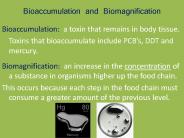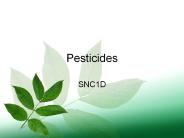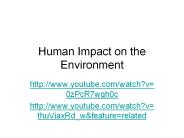Biomagnification PowerPoint PPT Presentations
All Time
Recommended
Bioaccumulation and Biomagnification Bioaccumulation: a toxin that remains in body tissue. Toxins that bioaccumulate include PCB s, DDT and mercury.
| PowerPoint PPT presentation | free to download
Oily liquids to solids. Non-flammable (high melting points) Electrical insulating properties ... In 1976, Congress passed the Toxic Substances Control Act (TSCA) ...
| PowerPoint PPT presentation | free to view
Introduction to biomagnification
| PowerPoint PPT presentation | free to download
Prevention of Biomagnification In an attempt to eradicate biomagnification, the U.S. and several countries worldwide have placed a ban on the use of DDT.
| PowerPoint PPT presentation | free to download
Biomagnification Biomagnification is the process where chemicals accumulate AND become more concentrated at each trophic level of the food chain. ORCAS ...
| PowerPoint PPT presentation | free to view
Ecology Notes Ch 3 Levels of Organization Cycles Energy Flow Symbiosis Predation Succession Biomagnification
| PowerPoint PPT presentation | free to view
Honors Biology Ch. 2 Principles of Ecology Biomagnification D. Nutrient (Biogeochemical) Cycles - organisms require essential nutrients for growth (CHNOPS ...
| PowerPoint PPT presentation | free to view
... or plants This occurs when pollution accumulates in higher trophic levels What is biomagnification ... is man-induced rapid extinction When CO2 gasses ...
| PowerPoint PPT presentation | free to view
Sustaining Biodiversity: The Species Approach Chapter 8 * * * Figure 8-11 Bioaccumulation and biomagnification: DDT is a fat-soluble chemical that can accumulate in ...
| PowerPoint PPT presentation | free to download
... Dennis Wentz Sources anthropogenic and natural Hg Hg+2 MeHg Methylation Hg Hg+2 Biomagnification PHg (particulate Hg) PHg Sed. Hg Hg ...
| PowerPoint PPT presentation | free to view
Biomagnification: is the progressive build up of persistent substances by successive trophic levels - meaning that it relates to the concentration ratio in a tissue ...
| PowerPoint PPT presentation | free to view
Bioaccumulation and Biomagnification Pesticides Pro and Con Kill unwanted pests that carry disease (rats, mosquitoes, Tse-Tse flies) ...
| PowerPoint PPT presentation | free to download
... dosage, bioaccumulation, biomagnification, synergism, response, acute effect, chronic effect ... Non-transmissible disease, transmissible disease, pathogens, ...
| PowerPoint PPT presentation | free to view
Water (runoff or leaching) Note many different kinds of nontarget effects ... Biomagnification = Increase in concentration of toxic products in higher ...
| PowerPoint PPT presentation | free to view
Figure 54.1 An overview of ecosystem dynamics ... Figure 54.4 Regional annual net primary ... Great Lakes Food Web. Biomagnification 'Bioaccumulation' ...
| PowerPoint PPT presentation | free to view
Biological Magnification http://waynesword.palomar.edu/images/ecology1.jpg Biological Magnification: Increasing concentration of a substance (toxin) in organisms in ...
| PowerPoint PPT presentation | free to download
Food chains If an ecosystem is ... use sun s energy Make their own food - autotrophs Consumers eat other organisms (heterotrophs) Primary eat plants ...
| PowerPoint PPT presentation | free to download
DDT. Background Information: Before 1972, DDT was commonly used as a pesticide; pesticides are chemicals used to kill pests like mosquitos. Overtime, DDT polluted the ...
| PowerPoint PPT presentation | free to download
Title: PowerPoint Presentation Author: McDougal Littell Last modified by: Jennifer McQuade Created Date: 9/14/2006 4:17:10 PM Document presentation format
| PowerPoint PPT presentation | free to download
Impacts of Humans on Ecosystems The biodiversity crisis Introduced species are those that humans have moved from native locations to new geographic regions.
| PowerPoint PPT presentation | free to download
Impacts of humans on ecosystems Rainforest- need to conserve them because: Ecological Economical Ethical Kudzu- Japanese plant that ate the south
| PowerPoint PPT presentation | free to download
Chapter 17 Human Health and Environmental Risks Three categories of human health risks physical biological chemical Biological Risks Infectious diseases- those caused ...
| PowerPoint PPT presentation | free to download
Environmental Awareness
| PowerPoint PPT presentation | free to view
Warm Up Turn in Tattoos and Food Webs. Study for Quiz. Have materials ready for Food Web Collage. Warm Up Turn in Tattoos and Food Webs. Study for Quiz.
| PowerPoint PPT presentation | free to download
Biological Diversity & Conservation
| PowerPoint PPT presentation | free to download
Nutrient Cycling and Human Impact
| PowerPoint PPT presentation | free to download
Ecology and Ecological Health
| PowerPoint PPT presentation | free to view
The fully customizable modular PowerPoint deck allows the ... Community Resources for ... Utilize Resources on-line Virtual File Cabinet http ...
| PowerPoint PPT presentation | free to download
Matter and Energy in Ecosystems Almost all energy in the ecosystem comes originally from the sun. Food chains show the direction of energy transfer.
| PowerPoint PPT presentation | free to download
Human Impact on the Environment
| PowerPoint PPT presentation | free to download
... Toxic Metals Program. Research Translation Core. Research: molecular mechanisms ... Translation defined: science communication with the goal ...
| PowerPoint PPT presentation | free to view
Human Impact on the Environment http://www.youtube.com/watch?v=0zPcR7wgh0c http://www.youtube.com/watch?v=thuViaxRd_w&feature=related
| PowerPoint PPT presentation | free to download
Nutrient Cycling and Human Impact
| PowerPoint PPT presentation | free to download
Crayfish. Cast of Food Web Characters ... Crayfish. Plant material and algae. 3-76 g/g ww (enough to cause death) 1-2 g/g ww ...
| PowerPoint PPT presentation | free to view
Environmental Science: Toward a Sustainable Future Richard T. Wright Chapter 16 Pests and Pest Control PPT by Clark E. Adams Genetic Control Introduction of genes ...
| PowerPoint PPT presentation | free to view
BASIC ENVIRONMENTAL TOXICOLOGY What is there that is not poison? All things are poison and nothing without poison. Solely the dose determines a thing is not a ...
| PowerPoint PPT presentation | free to download
What type of biodiversity are we referencing here? (genetic biodiversity) Remember the energy pyramid? ... have students check their endangered species card.
| PowerPoint PPT presentation | free to download
Who eats who in the food chain. Steps along which materials ... Magnification= to increase. Concentration of toxins. Are magnified. In upper pyramid levels ...
| PowerPoint PPT presentation | free to view
National geographic Typical person http://www.youtube.com/watch?v=4B2xOvKFFz4 Human population growth http://www.youtube.com/watch?v=sc4HxPxNrZ0
| PowerPoint PPT presentation | free to view
Ch. 46-47 Reproduction and Development Sexual vs Asexual Reproduction Under what circumstances would each be an advantage? When would each be a disadvantage?
| PowerPoint PPT presentation | free to view
Persistent Organic Pollutants in Marine Ecosystems. PoPs in ... Flounder. Gonad. Intersex Flounder. Endocrine Disruption. Molluscs TBT - IMPOSEX. Nucella ...
| PowerPoint PPT presentation | free to download
Chapter 11 - Water Section 3 Notes Water Pollution Water pollution Two underlying causes of water pollution: Industrialization Rapid Increase In Human ...
| PowerPoint PPT presentation | free to view
... pesticides remain active long period of ... Resistance Pest populations ... Fungicides-fungal pests that weaken plants Rodenticides- kill ...
| PowerPoint PPT presentation | free to download
Calcium from milk to already strong bones ... Summer flounder (Paralychthys dentatus) Sheepshead minnow (Cyprinodon variegatus) ...
| PowerPoint PPT presentation | free to view
Biology Ch. 2 Principles of Ecology
| PowerPoint PPT presentation | free to view
Ca-EDTA. Pb mimics Ca. Bone storage. ALAD. Hematocrit. Hemoglobin. Heme Precursor ' ... Max Daily Intake 100 ug. Max Blood Conc 100 ppb. EPA Tap Water 5 ppb ...
| PowerPoint PPT presentation | free to view
Title: PowerPoint Presentation Author: McDougal Littell Last modified by: Jennifer McQuade Created Date: 9/14/2006 4:17:10 PM Document presentation format
| PowerPoint PPT presentation | free to download
'Prejudices, it is well known, are most difficult to eradicate from the heart ... Oak trees, squirrels, hawks. 3 trophic levels. Have to find the appropriate balance ...
| PowerPoint PPT presentation | free to download
DDT A persistent pollutant * In lesson three the students will work with an osprey dataset. To familiarize students with some of feeding habits of osprey,the example ...
| PowerPoint PPT presentation | free to view
How do we minimize the toxic effects? How do we measure toxicity? ... Cells reproduce quickly to slough off and protect themselves this way. ...
| PowerPoint PPT presentation | free to view
Pesticides are degraded by many different mechanisms. Physical, chemical, and biological agents play significant roles in the transformation of insecticide, herbicide, and fungicide molecules to various degradation products. The physical and chemical properties of the degradation products are also different from those of the parent compound, and their fate and significance in the environment also are altered with the structural changes.
| PowerPoint PPT presentation | free to download
Human Populations and the Biosphere
| PowerPoint PPT presentation | free to view
Chapter 17 Human Health and Environmental Risks
| PowerPoint PPT presentation | free to download
























































